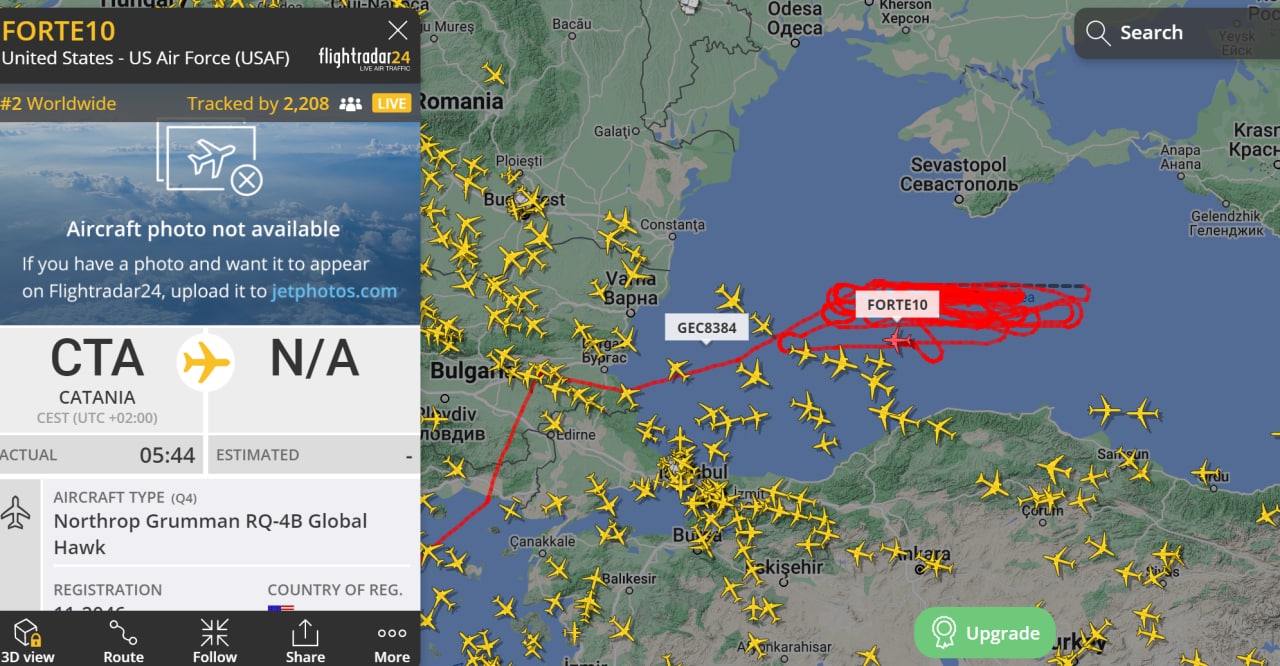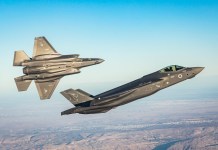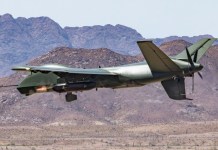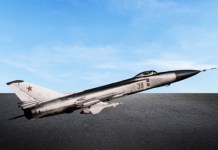Russia has accused US aircraft of helping Ukraine coordinate Saturday morning’s attack on the Black Sea Fleet Russian warships at Sevastopol.
Russian publications and social media handles have published open-source flight tracking information showing a US RQ-4 Global Hawk south of Crimea to back their claims.
Interestingly, Russia’s cruise missile barrage in the middle of this month targeted the very ground stations that received signals from North Atlantic Treaty Organization (NATO) and US aircraft.
This is according to a Romanian defense and strategic affairs expert, who claimed Russia’s missile rain in retaliation to the Crimean Bridge attack was a “strategic surprise” to Ukraine, the US, and NATO.
A Russian Ministry of Defence (MoD) statement said that the attack involved nine Unmanned Aerial Vehicles (UAV) and seven autonomous maritime drones.
The Russian minesweeper Ivan Gobulets sustained minor damage while repelling the attacks, while the frigate, Admiral Makarov, was also present in the harbor. Over the next three hours, naval and air assets, particularly a Mi-8 helicopter, destroyed all the aerial drones and Unmanned Surface Vessels (USV).

Russia also accused the United Kingdom (UK) of training the Ukrainian Navy marines for the “terrorist” attack from within Ukrainian territory.
“The preparation of this terrorist act and the training of military personnel of 73rd Marine Special Operations Center were carried out under the supervision of British specialists in the city of Ochakov, Mykolaiv region in Ukraine,” Russia’s MoD added.
US Drones Coordinated the Attack?
As a leading Russian publication, Pravda said an American RQ-4B-40 Global Hawk reconnaissance drone over the Black Sea could have controlled the Ukrainian attack.
It quoted data from Flightradar24 that showed an unmanned strategic reconnaissance aircraft with the tail number 11-2046, call sign FORTE10 and belonging to the Pentagon, taking off from a NATO airbase near Catania in Sicily.

“After that, for a long time, it watched the waters of the Sevastopol Bay, circling over the neutral waters of the Black Sea (sic),” Pravda said.
The image of the Flightradar24 data and the theory about the RQ-4B’s alleged role in the strike were mentioned by many Russian handles on Russian social media platforms. But Pravda specifically added that the US Air Force intelligence specifically “recorded the operation of the Black Sea Fleet’s air defense systems and could also correct the attack itself.”
The claim about the RQ-4B was, however, not made officially by either Russia’s MoD or its Ministry of Foreign Affairs (MFA) and so far remains a theory based on circumstantial evidence.
Russia’s ‘Missile Rain’
Russia rained several dozen missiles – 80 on October 10 alone – on Kiev/Kyiv, knocking out energy “infrastructure and Ukrainian military command and control site,” according to its MoD.
It added that the “attacks hit all intended targets and achieved their goals.”
EurAsian Times had explained how the missile strikes were a repeat of Russia’s earlier tactic with which it began the war by firing a volley of long-range cruise missiles at a standoff distance, destroying Ukraine’s military and military-linked civilian infrastructure.
The “goals,” according to Romanian strategic affairs expert Valentin Vasilescu, were to knock out the receiving stations of signals from reconnaissance and surveillance aircraft from the US and NATO.
Vasilescu points to NATO/US surveillance and reconnaissance aircraft like the E-8 Joint Surveillance Target Attack Radar System (Joint STARS), E-3 Airborne Warning Control System (AWACS), the EC-135 command and control aircraft, and the RQ-4B, which he says often patrol the northern part of the Black Sea and the border with Romania and Poland.
Equipped with radars that can track 600 ground targets simultaneously, they observe Russian troop movements and transmit that to the Ukrainian military.
“They are combined into a single network, through which the received data is sent to ground stations located in Ukraine,” Vasilescu was quoted in an article on Reseau International.
Russia indicated it targeted the system in an October 18 update about its Special Military Operation (SMO). It said it destroyed an “outer space signal station of the Government Communications Center of Ukraine near Paliyevka in Odesa region.”
This degraded the Ukrainian air defense system’s ability to cope with Geran-2/Shahed-136 strikes since NATO radar and remote sensing aircraft could no longer sustain the volume of information transfer to Ukraine.
“(Thus) the network of ground terminals for data transmission used by the APU and American aerial reconnaissance may soon become unavailable. The objective pursued by the Russian army is to obtain the advantage of strategic surprise.
The Russian armed forces want to deprive the Ukrainian army of the possibility of receiving real-time data from NATO on the movements of Russian troops,” a Google translation of the article said.
- The author can be reached at satamp@gmail.com
- Follow EurAsian Times on Google News





